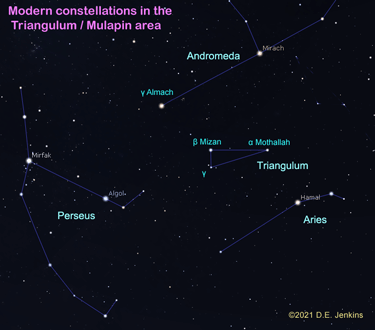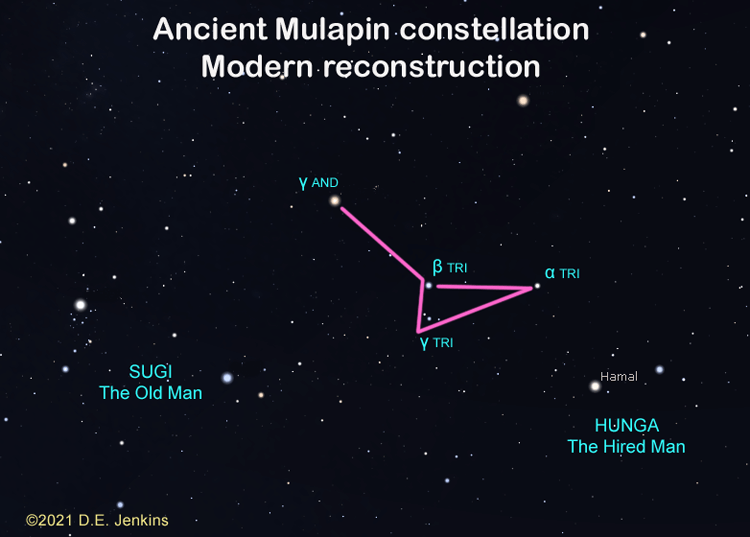
September 2021 - Vol. 25, No. 9
This Month's Night Sky - NOTE: The next paragraph describes the sky as it appears at 10 pm EST (11 pm EDT) near mid- month. The sky also looks this way at 11 pm EST (midnight EDT) during the beginning of the month and at 9 pm EST (10 pm EDT) by month's end.
The Summer Triangle asterism, Vega (Lyra), Deneb (Cygnus) and Altair (Aquila), is still quite prominent overhead as darkness falls. Arcturus (Bootes) is now dipping to the NW horizon. From a dark site, the myriad stars of the Milky Way (the visible "arm" of our galaxy), "flow" eastwards through the "W" asterism of Cassiopeia and to bright Capella (Auriga) glowing in the NE. "The Great Square of Pegasus" asterism burns high in the SE while lonely Fomalhaut (Piscis Austrinus)shines far below, very close to the horizon. "The Big Dipper" asterism (Ursa Major) is nearly horizontal and now sits low on the N horizon. In the E, Aldebaran (Taurus) shines, a sure sign of Autumn.
MERCURY favors southern observers in the evening sky. VENUS favors the southern hemisphere in the evening sky, passes by the first magnitude star Spica on the 5th. MARS too close to be seen as it approaches conjunction with the Sun. JUPITER dominates the evening sky. SATURN in retrograde motion in Capricornus. URANUS rises before midnight this month. NEPTUNE will be at opposition in Aquarius on the 14th, it's magnitude will be +7.8.
Review how to determine Angular Measurement.
Calendar of Events
NOTE: For those observers not in the ET zone, convert the calendar times to your zone's time by subtracting one hour for CT, two for MT and three for PT. Don't forget to adjust for Daylight Savings Time when necessary by subtracting one hour from your planisphere's time. Dawn and dusk times must also be corrected. See your local newspaper, TV news, or cable TV's Weather Channel for sunrise and sunset times or check with the U.S. Naval observatory. Unfortunately some of these events may occur during daylight hours in your area.
| DATE | EVENT |
| 01 | Moon at apogee 1.3 deg. N of M35. |
| 05 | Venus 1.7 deg. N. of Spica. The Zodiacal Light or "false dawn" is visible in the E about 2 hours before sunrise. This pyramidal glow is caused by meteoroids, dust particles spawned by passing comets, etc., that have settled into the ecliptic plane (path followed by the Sun, Moon and planets), reflecting the Sun’s light before it rises here. This phenomenon will be visible for the next two weeks. |
| 06 | Mercury at aphelion. |
| 10 | Venus 4 deg. S. of Moon. |
| 11 | Moon at perigee. |
| 14 |
Mercury at greatest elongation E. (27 deg.) Neptune at opposition. |
| 17 | Saturn 4 deg. N. of Moon. |
| 18 | Jupiter 4 deg. N. of Moon. |
| 22 | Equinox, Sun rises due East, sets due West. |
| 23 | Mercury 1.7 deg. S. of Spica. |
| 24 | Uranus 1.3 deg. N of Moon. |
| 26 |
Moon at apogee. Mercury at greatest heliocentric lat. S. |
| 27 | Mercury stationary. | 28 | Moon 1.6 deg. N of M35. |
| 30 | Mercury 1.7 deg. S. of Spica. |
Lunar Almanac for September 2021
| Phases of the Moon | Phase and Date(s) | Best viewed before local midnight |
 |
New 06 |
Deep Space Objects |
 |
1st. Qtr 13 |
Planets & Moon |
 |
Full 20 |
Moon |
 |
Last Qtr 28 |
Deep Space & Planets |
Topic of the month: Mul Apin

The stars of the Plow constellation come from the modern constellation, Triangulum, whose brightest star is called Mizan at 3.0 mag. It is the Beta star rather than the fainter Alpha star called Mothallah (3.4 mag) or Caput Trianguli. The triangle is completed by Gamma Trianguli, a star with no common proper name. Almach completes the ancient constellation.
The rising of Mulapin with the Sun helped the ancient Mesopotamian astronomers to identify the exact time of the Spring equinox. Astronomers and calendar keepers are sometimes called priests because they were employed by the temple. But they were not priests, they were dedicated astronomers. It is true that they watched the stars to read the "signs" in the sky. This is because they believed the Gods were sending them messages. The meanings of these signs were kept in texts that modern scholars call "Enuma Anu Enlil". The astrology of the ancient Mesopotamians was not astrology as it is known today - - that is derived from ancient Greek astrologers. The fact that Mesopotamin astronomers worked for the temple and used a text to interpret planetary motions does not diminish the quality of their science. They knew the sky better than astronomers of today and they lacked the tools of modern times. Ancient Mesopotamians provided the base for our modern astronomy through an observing program that they conducted for about 800 years.
Because observing conditions in Mesopotamia were not always the best, the ancient astronomers devised a method of tracking the location of stars they were interested in using other stars that they could see. These stars were called "zigpu"stars. Their observational methods allowed fairly precise celestial measurements. This process was assisted by their lunar calendar keeping system that is beyond the scope of this article. Zigpu stars helped them decide that Mulapin was about to emerge in the early morning sky. Although they followed a lunar calendar, they understood the important positions of the Earth in relationship to the Sun.
In order to understand the constellation better, we've reconstructed the ancient constellation of Mulapin in the image below. Two other figures are noted, one is Sugi or the Old Man seen by the ancient astronomers. This is today's constellation of Perseus, a Greek hero. Perhaps the ancients saw Perseus as a bent over old man. As for the other character noted among the stars of Aries, the hired man or Hunga, this constellation represented the workers who were hired to help clean up the irrigation ditches or till the ground for the new harvest. They would be hired around the time of the year the constellation was rising in the early morning hours. Maybe the old man hired the worker to use the plow in the field. In any case, they probably incorporated some of the stars of the constellation of Cetus that are also near the ecliptic.

The ancient astronomers in Mesopotamia had a rich lore surrounding the constellations in the sky. The next time you encounter the Mul.Apin, remember it is only called that because that is the first word on the clay tablets where the ancient scribes recorded their astronomical knowledge. MulApin itself is a small constellation that helped humans keep up with solar time, a Star Plow.
--See You Under the Stars!
Astra for Astra's Almanac
This installment of "What's Up?" is ©2021 by Dawn Jenkins for Astra's Stargate. View Ron Leeseburg's Farewell Issue for information on where to find information such as is presented in this almanac.